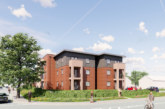New measures to level up England’s cities, recover from the pandemic and help provide much-needed new homes have been set out by Housing Secretary Robert Jenrick.
Following a consultation launched in the summer that sought views from planners, councils and the wider public, the Government has announced its plan for enabling the delivery of more homes across England.
A housing need formula is currently used to provide a starting point in the process of local planning for new homes. An updated method will now be introduced to help councils to enable the delivery of 300,000 homes a year by the mid-2020s, while prioritising brownfield sites and urban areas.
Under the proposals, cities will be encouraged to plan for more family homes — which are the right size and type for families to live in — and to make the most of vacant buildings and underused land to protect green spaces. The plans will encourage more homes to be built in England’s 20 largest cities and urban centres, boosting local economies by supporting jobs in the building sector, and revitalising high streets with the footfall new residents bring.
The Government also intends to revise the so-called ‘80/20 rule’, which guides how much funding is available to local areas to help build homes. This will establish a new principle to ensure funding is not just concentrated in London and the South East.
Housing Secretary Rt Hon Robert Jenrick MP said: “This government wants to build more homes as a matter of social justice, for intergenerational fairness and to create jobs for working people. We are reforming our planning system to ensure it is simpler and more certain without compromising standards of design, quality and environmental protection.
“The COVID-19 pandemic has accelerated and magnified patterns that already existed, creating a generational opportunity for the repurposing of offices and retail as housing and for urban renewal. We want this to be an opportunity for a new trajectory for our major cities — one which helps to forge a new country beyond COVID — which is more beautiful, healthier, more prosperous, more neighbourly and where more people have the security and dignity of a home of their own.”
A new expert Urban Centre Recovery Task Force has been set up to advise on the development and regeneration of our great town and city centres. The Task Force includes Peter Freeman, the visionary behind the redevelopment of Kings’ Cross and new Chair of Homes England.
To further support local areas in delivering these homes, and following the £20bn investment in housing announced as part of last month’s Spending Review, the Government is also:
- Allocating more than £67m in funding to the West Midlands and Greater Manchester Mayoral Combined Authorities to help them deliver new homes on brownfield land, as well as confirming an additional £100m of funding for brownfield development.
- Announcing that in January the Government plans to launch a new £100m Brownfield Land Release fund to support brownfield development, estates regeneration, development on public sector land and self and custom-build serviced plots in coming forward. This will be open to councils across England, apart from those Mayoral Combined Authority areas that recently benefited from our £400m brownfield fund. A significant portion of this new £100m will to go supporting self and custom-builders — a growing sector which Government is committed to. We invite councils to use the time between now and the prospectus launch to start to consider and prepare their bids.
- The Government is encouraging councils to ensure that appropriate numbers of family homes come forward, with the right mix of home sizes, types and tenures for local communities.
To ensure tall buildings are in areas that are appropriate, the Government has issued a London Plan direction to the Mayor of London asking boroughs to set a definition for a tall building, based on a minimum of 18m height.
LGA response to government housing announcement
Responding to the announcement by the Housing Secretary of how the Government plans to deliver new homes, Cllr David Renard, Local Government Association Housing Spokesperson, said: “We are pleased the Government has acted on the LGA and councils’ concerns about its proposed updates to the housing formula.
“We have been clear all along that algorithms and formulas can never be a substitute for local knowledge and decision-making by councils and communities who know their areas best.
“It is good to see that future government investment will support the building of new homes, where they are needed.
“It is right that councils should have access to funding to support their ambitions, as they are in the best position to determine local housing need, instead of this being prescribed centrally.
“This should include reform to Right to Buy so councils can keep receipts in full and set discounts locally, enabling them to provide the housing communities need, supported by the required services and infrastructure.
“With council housing waiting lists set to potentially nearly double next year, we need to let councils embark on an ambitious post-pandemic building boom of 100,000 social homes for rent a year, which as well as reducing homelessness would also deliver a £14.5bn boost to the economy.
“The extra funding for brownfield development announced at the Spending Review is positive. The LGA is working with the Cabinet Office and Ministry of Housing, Communities and Local Government, through the One Public Estate programme, to ensure councils are supported to use this funding to best address their local needs.”
District councils respond to Government’s plans to regenerate England’s cities with new homes
Responding to the Government’s plans to regenerate England’s cities with new homes, Cllr Mark Crane, District Councils’ Network Lead Member for Stronger Economies, said: “The building of new homes is core business for district councils that continue to approve nine in 10 planning applications. We are committed to the aim of building 300,000 homes a year, and to creating high-quality, well-designed places that people are proud to call home.
“It is welcome that the Government has listened to councils and decided not to pursue the imposition of undeliverable new housing targets in many local areas. While there will always be difficulties in applying a national formula into local realities, the reversion to the previous methodology is a positive move and provides many places some certainty through which to push forward on our housebuilding ambitions.
“We look forward to working with the Government to build the right homes in the right places, for instance where tall buildings might work best in some areas and reduced density in others. It will be important that the Government takes account of the impact that the pandemic may have for housebuilding, and creates the necessary flexibilities within the Housing Delivery Test to ensure that our communities who back development are not penalised if the builders slow down.”
Header image ©Romolo Tavani/AdobeStock.









